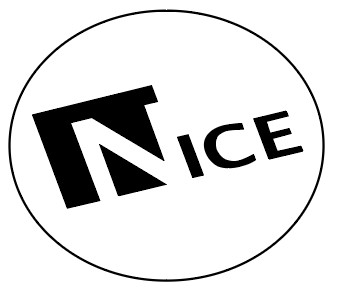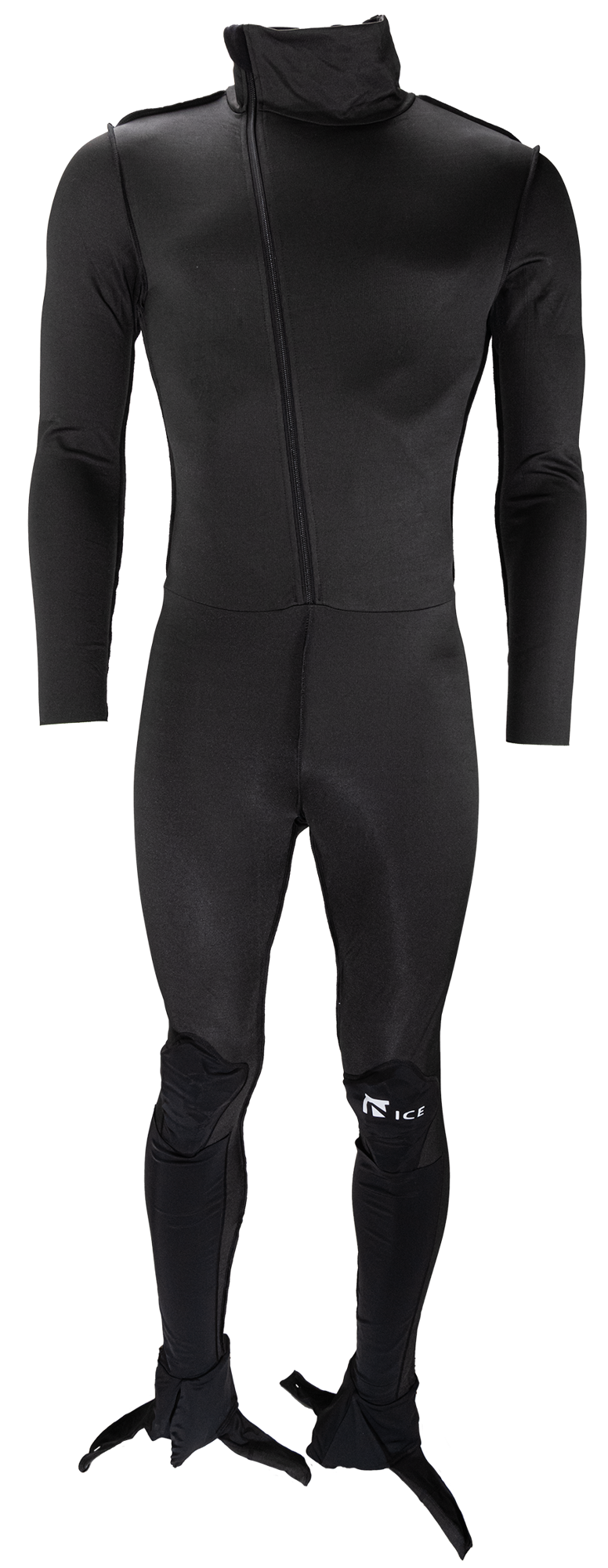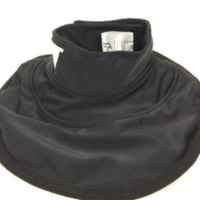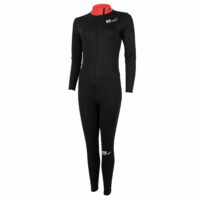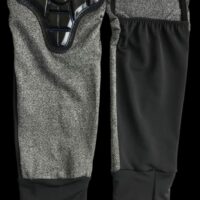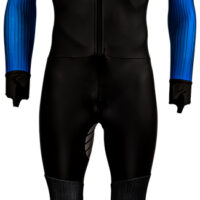Nice Extreme Snijvast Shorttrack schaatspak
€299,95
Nieuwe Extreme snij vast schaatspak van Nice is volledig snij vast level 3 volgens de richtlijnen van de KNSB en ISU.
Wat is het verschil tussen Basic en Extreme.
Extreme is voorzien van knie padding die om de knie heen vouwen(deze zijn ook te verwijderen)
Extreme is voorzien van een pocket voor harde scheenbeschermers wij adviseren simpele voetbal scheenbeschermers.
Extreme is ook nog eens voorzien van enkelsokken die over de schaatsschoen heen gaan en aan de onderkant vast gemaakt worden met een klittenband.
Het snij vast schaatspak beschikt over goede thermische eigenschappen en beschermd je lichaam tegen snijwonden door ijzers. Dit schaatspak is geschikt voor schaatswedstrijden en trainingen voor de shorttrack,Marathon of massastart
Het materiaal is aan de binnenzijde zeer zacht en bedoeld voor hoog draagcomfort ook zijn de pakken erg licht.
Het materiaal beschikt daarnaast over ademende en regulerende eigenschappen, het lichaam wordt minder zweterig en raakt niet over verhit.
Het nieuwe schaatspak voldoet aan de Nieuwe Isu normen voor seizoen 2021/2022 ISU:1265
Hieronder klein stukje tekst uit het regelement van de ISU.
Nice Snijvast schaatspak
Het Nice snijvast schaatspak is volledig snij vast en volledig beschermt met level 3 snijvast materiaal we hebben het pak in 2 uitvoeringen de Basic & Extreme.
Het verschil in de pakken zit niet in het materiaal maar in de extreme zit een pocket voor de harde scheenbeschermer ook zitten er knie pads in het pak die eenvoudig te verwijderen zijn en er zit een enkel beschermer aan het pak deze dient u over de schaats heen te doen en onderop met de druk knop vast te zetten.
Het Nice snijvast schaatspak beschikt over goede thermische eigenschappen en beschermd je lichaam tegen snijwonden door ijzers.
Het materiaal is aan de binnenzijde zeer zacht en bedoeld voor hoog draagcomfort ook zijn de pakken lichter geworden.
Het materiaal beschikt daarnaast over ademende en regulerende eigenschappen, het lichaam wordt minder zweterig en raakt niet over verhit.
Maatvoering:
De Basic & Extreme hebben beide een standaard maatvoering van 4XS tot 2XL.
Mocht het nou zo zijn dat u toch een S nodig heeft kwa breedte maar een M of L kwa lengte dan kunnen wij bijvoorbeeld de S met langere benen en armen maken.
Dat u op de juiste manier optimaal beschermt bent tegen snij wonden.
| Maat | Lichaamslengte |
| Custom | in overleg |
| 4XS | 130-140 |
| 2XS | 140-150 |
| 2XS | 150-160 |
| XS | 158-165 |
| S | 164-170 |
| M | 169-175 |
| L | 174-181 |
| XL | 179-185 |
| 2XL | 180-190 |
Het nieuwe schaatspak voldoet aan de Nieuwe Isu normen voor seizoen 2021/2022 ISU:1265
Hieronder klein stukje tekst uit het regelement van de ISU.
2. Cut Resistant Clothing
The special areas of risk identified during the initial study made in 2004 are still valid. These areas
include the neck, groin, axillar region, gluteal region, lower arms, hands, back and front of the knees.
Based on a high number of cuts around the ankle, also this area is now added as a high-risk area.
The risk areas are identified as
• zones where the risk of life-threatening injuries involving a laceration of a major artery / vein
can happen (red & yellow zones);
• zones where there is a higher risk of getting a serious laceration (green zones).
2
Depending on the level of performance in competition and training, these areas and other areas
must be protected against injury.
In order to determine the suitability of competition clothing materials for Short Track Speed Skating,
tests were carried out to simulate the effect of extreme falls and determine the cut resistance quality
of materials. Through statistical and error analysis, the results from these tests have been correlated
with test results using the same materials under international standard EN388 (this widely recognized
standard will be familiar to clothing manufacturers*1). Using the test data, an equation has been
determined which makes it possible to test a material according to standard EN388, and then assess
its suitability for Short Track Speed Skating.
Since 2016, the standard EN388 (see also ISO 13997) includes a pressure test. The ISU will
investigate if such test is applicable for situations in Short Track Speed Skating. If so, further
recommendations and/or requirements on cut resistant suits will follow, but not before season 2022/23.
At the time of issuing the previous ISU Communication 1265, there were no fabrics existing that could
meet Level 3 or 4 of the EN388 Cut Resistance Standard. Therefore, under the EN388-2004 Cut
Resistance Level 2 was set as the minimum standard for Racing Suits.
The fabrics were heavy, not breathable, and not stretchable; so only high-risk areas were mandatory
to be covered. With the recent improvements on the fabrics, there are full body suits that are more
comfortable (lighter, breathable, dryer), and also less expensive. They can be purchased in every part
of the world. As recent observations also show that stitches in the uniforms weaken the fabrics and
that a blade could reach a high-risk zone by entering via a non-protected area of racing suits, this
Communication makes full-body suits or full-body underwear required instead of previous
requirements that only high-risk zones had to be covered with cut resistant fabrics.
No limitations will be imposed on the manufacture of protective competition clothing/uniforms other
than the protective material must comply with Standard EN388. At the moment of issuing this
Communication, Level 5 cut resistant racing suits are already in development.
*1 https://www.en-standard.eu/search/?q=en388
3
Due to the availability of better fabrics, the ISU recommends that all ISU Members who will be
purchasing new outfits for the season 2021/22 implement the new safety guidelines as specified in
paragraph 2.1 below, already for such purchase.
From the 2004 study, it was established that the minimum required level of cut resistance, as specified
in Standard EN388, needs to be higher for heavier and faster skaters. This is mainly true for injuries
happening when two skaters fall and hit the paddings together. But many injuries actually happen
during the race with skaters following each other closely, independently of their speed and weight.
Recently collected statistics also indicate that more injuries are happening in training and in other
competitions with younger skaters than with national team skaters and in ISU Events. For that reason,
this Communication also includes recommendations for all levels of Skaters competing in short track,
and not only for the ISU level.
